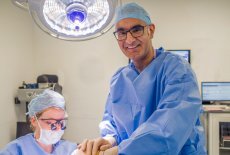Breast Uplift
Bilateral Breast Reduction/Mastopexy
Who would benefit from this procedure?
Breast reduction is for those women who have a large bust which causes problems with bras digging into the shoulders, neck/shoulder ache, difficulty buying bras/clothes which fit or interference with day to day activities/sport.
Mastopexy (breast lift) is for those women who have noticed a significant droop in their breasts (ptosis). This may be associated with loss of breast volume. Ptosis may occur as a natural function of age or after pregnancy. Mastopexy lifts up the breasts but in addition can also restore lost volume with the use of breast implants.
In both cases the surgical technique is similar with the main difference being that with breast reduction breast tissue is removed and reshaped, whereas with mastopexy the breast tissue is reshaped (with a small amount of tissue removed if necessary). In both situations, the breasts are lifted. Ideally women having either procedure should be close to their ideal weight to reduce the risk of complications.
How is it done?
Breast reduction/mastopexy is performed under general anaesthetic. There are three common scar patterns and Mr Dheansa will have discussed the most suitable one for you at your consultation.
They are the vertical (lollipop) scar, the peri-areolar (donut) and anchor pattern scars. The principles are the same for all with the main differences being that the vertical scar results in a scar with ruched skin that takes a few months to settle down.
Once fully anaesthetised the skin (and breast tissue) is excised according to the markings made before the operation. The nipple/areola is kept attached to a piece of breast tissue to preserve its blood supply and this is relocated into its new higher position. The breast tissue is then reshaped and the skin closed using dissolving
stitches under the skin. A drain is sometimes inserted to collect any excess blood and this comes through the skin on the side of the chest. A shower-resistant dressing is then applied.
If breast tissue has been removed it is sent for analysis to ensure that there is no abnormality.
In some cases breast implants are used to aid the effect of a mastopexy. If they are used the implants are usually inserted through a separate skin excision. There is a separate information leaflet available regarding breast implants.





What happens before surgery?
Mr Dheansa will fully assess you for suitability and any further procedures at the consultation. It is important to discuss specific desires and outcomes before committing to surgery. It is also essential to mention previous breast surgery and family history of breast conditions. Knowledge of general health will help assess fitness for general anaesthetic. At the end of your consultation you should be clear about incisions, areas to be treated, other procedures, length of stay and potential outcomes.
If you are unclear about any aspect of your care or the procedure itself you must contact Mr Dheansa (contact details below) to clarify the situation before committing to surgery.
If you are over 40 it is good practice to have a mammogram before surgery to ensure the breast tissue has no problems before surgery.
You should bring in a light support sports bra or vest type bra in a size close to your chosen size. Ask Mr Dheansa if you need further advice in this regard.
You will normally be admitted to the hospital on the day of surgery. Your anaesthetist will see you and you will have an opportunity to discuss your anaesthetic with him/her. Mr Dheansa will review you before your operation, go over the procedure again and mark the breasts to plan the amount of tissue to be removed. You will sign a consent form confirming that you are aware of the risks, complications and benefits of the operation. If you have any last minute questions please make sure that you ask them at this stage.
After the Surgery
What happens after the surgery?
You will be in hospital for 1-2 days after the operation. As soon as possible after you arrive on the ward the nursing staff will get you into a bra to provide support. You should wear this all the time (except for when showering) for the first few weeks. The nursing staff will ensure you have adequate painkillers throughout your stay.
Mr Dheansa will review you daily to ensure all is well. Your drains (if you have them) will be removed on the day of discharge or the night before and arrangements made for follow up. You will be given painkillers to go home with and you should ensure that these are taken regularly.
What should I expect post-op?
It will take at least 2 weeks for your wounds to heal and you will need dressings for at least this time. Sometimes it can take longer. It often takes 1-2 weeks for pain or soreness to settle but in some people it can take longer.
If you notice any increased oozing or redness you should contact the hospital or Mr Dheansa as you may need to be seen sooner than your planned appointment.
After 12 weeks it is best to moisturise the area with a simple cream such as E45. Apply it along the scar twice a day for at least 6 weeks. Massage the scars along their length with firm strokes to help them mature.
Post Operative Care
These advice pages give general guidance on care after your surgery. Mr Dheansa will have discussed any specific do’s and don’ts with you before your surgery but if you are not sure please ensure you check these pages or contact us.
What can I do and not do at home?
Once home, you should take your pain killers regularly. Make sure you have enough support to help you at home.
It is important that you take things easy for the first 2-4 weeks after the operation. You mustn’t drive for 2 weeks nor perform any strenuous activity for 4 weeks. You should keep your bra on all the time except when showering for 2 weeks and then only during the day after this time. The dressings you have should be shower-resistant, but it is important to avoid baths or swimming until all is healed. You will be kept under review until all your wounds have healed and your breasts have fully settled.
You can gently moisturise and massage your breasts (except for the scars/dressings) after a week. A simple moisturiser like E45 is best.
Once everything has healed apply Micropore tape along the scars and keep it on continuously. You can shower/wash with the tape on. If it peels remove it and apply some more. Keep it on for 12 weeks. The tape helps the scars mature and settle.
After 12 weeks it is best to moisturise the area with a simple cream such as E45. Apply it along the scar twice a day for at least 6 weeks. Massage the scars along their length with firm strokes to help them mature.
Will my scars change?
All scars go through a maturing process and go through a series of changes before settling down. This process varies from person to person as well as from site to site on the same person. Generally once a wound has healed the scar will be a thin pale line. Over the ensuing 6-12 weeks the scar may become raised, pink and wider. It often
becomes itchy too. It then stabilises before slowly becoming flatter, paler and less itchy. This can take up to a further 12 months. Even after this time scars continue to improve but at a much slower rate.
Avoid sunlight on the scar for the first year to avoid it getting burnt and then subsequently dark. It is very hard to make it pale again. Mr Dheansa will advise you of any further precautions or actions if required.
Things to Consider
It is important to be prepared before and after your surgery. Here are a few things to consider about this operation.
Changes over Time
As with all surgery there is a period of time after healing when the breasts will settle. They will, over several months, become less tight and achieve a more natural appearance. However, over the ensuing years the breasts will continue to change as they might have without surgery. This may mean that in several years’ time further surgery may need to be performed.
Asymmetry
People are rarely exactly symmetrical and the intention of any surgery is to get both sides as equal as possible. However, the healing process is not always predictable and may result in minor differences from one side to the other.
Breast Feeding
As breast reduction takes away glandular tissue and the connections between the remaining tissue and the nipple are disrupted, breast feeding after surgery may not be possible. Even if breast feeding is possible the volume of breast milk produced may be significantly reduced.
Abnormal Scars
Sometimes even if all heals well a patient may develop abnormal scars (pink, wide, raised and itchy). Patients may already have noticed such a tendency from previous scars. Such scars take a very long time to settle (up to 18 months) and may be difficult to treat.
Bruising/Swelling
Some patients may experience some bruising. This often results in increased swelling and some tenderness. The skin may become discoloured and take a few weeks to settle down.
DVT/PE/Chest Infection
Clots in the leg (DVT) or lungs (PE) or chest infection are uncommon with this operation.
Numbness
The treated area will lose sensation (feeling) after the operation and it will take several weeks for it to return. Some areas may remain numb.
Pain
Usually controlled with painkillers and again often resolves within a week or so.
Are there any potential risks?
There are potential risks and complications with any operation and it is important to be aware of them before committing to any surgery. You may also have particular circumstances that affect the final outcome and these will be discussed with you at your consultation.
Anaesthetic
You will be assessed for fitness for anaesthetic and providing this is appropriate the risks from general anaesthetic are low. Anaesthetic can sometimes cause a reaction though this is very rare.
Bleeding
Rarely there may be significant bleeding under the skin that does not settle. Should this occur you may have to return to theatre to control the bleeding. This should not have any long term effect should it occur.
Wound Infection
Wounds can get infected. If you notice increasing redness, pain or an offensive odour from the wound, contact Mr Dheansa as soon as possible. If this should occur you will need to have antibiotics and frequent dressings. The wound may take longer to heal.
Dog Ears/Change in Contour
Some wounds can result in a slight dip in the middle if the tissues are not elastic enough. Dips tend to improve over time. Conversely the ends of a wound may have slight bumps (dog ears) which again usually settle but may require a minor procedure to correct.
Fat Necrosis
The fatty tissue within the breast can be quite sensitive to surgery as it has a poor blood supply. In some cases small areas of fatty tissue can become inflamed. This can lead to a discharge from the wound or the formation of a firm lump that may take a long time to resolve.
Delayed Wound Healing
Sometimes if there is a lot of swelling or bruising or infection the wound may open up. In such circumstances you may need to have dressings for a few weeks and the resulting scar may be less than perfect.
Download Procedure Information
Download Consent Form
Download Breast Reduction Consent Form
Frequently Asked Questions
How long is the operation?
About 3 hours.
When can I shower?
Straight away as you will have a water resistant dressing.
How long should I keep taking pain killers?
You will often need pain killers for at least a week but everyone is different, you may need to take them for longer.
When can I go to the gym?
You should avoid the gym until about 4 weeks after the operation but check with Mr Dheansa first.
How long until the final result?
It takes about 3 months for your breasts to settle.
When can I fly?
Generally it is ok to fly 2-3 weeks after the surgery but this depends on the length of flight and your recovery. Check with Mr Dheansa before flying.
Download Further Information
Click here to check out these handy information packs that you can download



